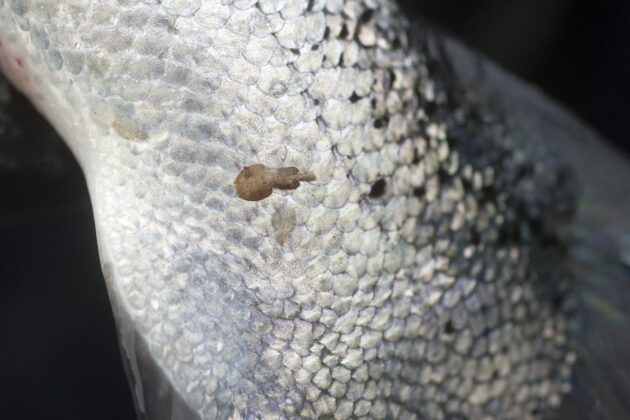Drawing on the natural abilities of Pacific salmon to fight sea lice

Do Pacific salmon species carry a secret they could share with Atlantic salmon? What is it in the genes that make these relatives of Atlantic salmon less susceptible to lice? Researchers will now find the answers to these questions, and they will use the method that just received the Nobel Prize in Chemistry – gene editing using CRISPR-Cas9.
Sea lice are naturally occurring parasites that attach to and feed on salmon. Infestation of Norwegian salmon farms is common and severely affects the welfare of fish if unchecked. Innovation in the salmon industry and strict rules keep the severity of infestation low, but at a high price for the farmed salmon itself, which often has to be treated to remove lice. Now researchers are aiming to apply new Nobel Prize-awarded methodology in a way that could make farmed salmon an unattractive host for sea lice.
Sea lice pose one of the biggest challenges facing the aquaculture industry worldwide. The cost to the Norwegian industry from the impact and treatment of sea lice is more than NOK 5 billion per annum. Existing methods for preventing lice infestation are not entirely effective. Lice wound and stress the fish, and this can lead to death if left untreated, but the most effective methods of treatment (such as mechanical de-lousing) can also substantially stress the fish. Furthermore, common therapeutics can be damaging to wild ecosystems, and lice frequently develop drug resistance making the treatments less effective. The aquaculture industry is therefore looking for an environmentally friendly solution that can effectively limit lice attachment with little/no negative impacts on fish welfare.
A typical salmon farm contains many potential hosts for lice and provides ideal conditions for the lice to mature and reproduce. Salmon farms can therefore promote the multiplication of lice. If the number of sea lice attached to farmed salmon and the ability of the lice to mature and reproduce could be suppressed, the reduced numbers of lice would benefit both farmed and passing wild salmon. Researchers believe that a solution to the sea lice problem in Norway may lie across the Atlantic.
The key to sea lice resistance may be found in North America
Research has shown that several species of Pacific salmon are unattractive as hosts for sea lice. Detailed research is needed to uncover the genetic basis for these differences and to see if this knowledge can be utilised in a way that helps prevent sea lice infestation among farmed Atlantic salmon.
In an effort to provide solutions to the sea lice problem genetics researchers at Nofima, along with partners from the United Kingdom, the United States, Canada, Sweden and Australia, and fish breeding and production companies, are embarking on a groundbreaking new project with funding from the Norwegian Seafood Research Fund (FHF).
“It is no exaggeration that the knowledge we create in this new project could transform the Norwegian aquaculture industry if Atlantic salmon can be made to be highly or completely resistant to lice”, says senior researcher and project leader Nick Robinson in Nofima. He has extensive experience from genetic and breeding research on disease resistance in aquatic species farmed worldwide.
So why is it this particular research could have a decisive effect?
The answer is gene editing
This year, the Nobel Prize in Chemistry was awarded to Emmanuelle Charpentier and Jennifer Doudna for the development of a gene editing method utilizing CRISPR-Cas9 “genetic scissors”. This is the method that the researchers in this project will use as an ultimate test of which genes affect how attractive salmon is as a host to lice.
The genetic code influences the function and development of all living things. Differences in the genetic code make Atlantic salmon more attractive hosts to lice than coho or pink salmon. Such differences, for example, could result in the production of chemical attractants by Atlantic salmon but not by coho, or result in an effective defensive response of the salmon skin to newly-attached lice in pink salmon but not in Atlantic salmon.
The research aims to find the genetic basis for these differences between Atlantic and North American salmon species.
“If we can reveal the differences in the genetic code that cause lice to be attracted to Atlantic salmon, or that makes the skin of North American salmon a bad place for sea lice to settle and develop, then it may be possible for us to use that information to make Atlantic salmon resistant to sea lice, and have better health”, says Robinson.
CRISPR-Cas9 is tool that makes it possible to make targeted changes to the genetic code. For instance, CRISPR-Cas9 could be used to delete a few base sequences of the code to disrupt a gene’s function. But an intense research effort is needed, first to determine which genes could be edited to have the desired effect, and secondly to be able to successfully make the desired edits.
“CRISPR-Cas9 is still a relatively new technology in the aquaculture research, but can allow for very precise and targeted changes at specific genes in the salmon genome known to be involved in cross-species variation in resistance to lice and the success of its use depends on the type of change that is needed and on the position and code of the gene to be edited” says Professor Ross Houston of the Roslin Institute UK whose team will work closely with Nofima on this and other parts of the project.
Research needed to find promising genes
The researchers will find and measure the chemical components that each salmon species releases. Then they will test how sea lice react to each of the unique chemicals released by Atlantic salmon, and reveal which of them are semiochemicals that can attract or repel lice.
“We can observe whether lice are excited and stimulated to swim towards these chemicals”, says partner Howard Browman of the Institute of Marine Research in Norway.
They will also undertake experiments to study the response to attached lice by different cell types in the salmon skin, and how this response differs in the resistant North American species.
Finally, the researchers will determine what genes are affecting the production of these semiochemicals and affecting the response of different cells in the skin, and test how these genes can be “disrupted” using CRISPR-Cas9 to make Atlantic salmon unattractive to lice.

Tested thoroughly
If the researchers succeed in carrying out gene editing in the laboratory, the salmon must be thoroughly tested up to adult size in closed facilities to investigate how effective the change is and to reveal any potential unwanted side effects. Robinson emphasizes that this project will not make genetically edited fish available to industry and that further testing will be needed.
They will also consider risks of sea lice adapting to the changes in the salmon, and how this would be best prevented.
“Lice adapt to become resistant to chemical treatments, and we need to consider if they might adapt to overcome any specific changes that are made to Atlantic salmon” says partner Tim Dempster from the University of Melbourne, Australia.
The project will also consider possible effects on wild salmon populations.
“In the project, we will determine how the changes would be best implemented in a farming population, to make all Norwegian farmed salmon resistant to lice”, says Robinson.
It is up to the aquaculture industry and the authorities, in consultation with other stakeholders, to determine whether these new tools can be deployed and, if so, the best approaches to their introduction.
The researchers will follow so-called RRI guidelines (responsible research and innovation).
“We will invite NGOs and others who are interested in seafood production to get input on what social and moral consequences the research and possible implementation could have for Norwegian society. With such input, we can adjust the work underway and create a responsible plan that balances animal welfare, ethics and law”, says Robinson.
The project will be led by the Norwegian Fisheries, Aquaculture and Food Research Institute – Nofima, and involve close collaboration with research partners the Roslin Institute (University of Edinburgh, UK), the Institute of Aquaculture (University of Stirling, UK), Rothamsted Research (UK), the University of Melbourne (Australia), University of Prince Edward Island (Canada), Bigelow Laboratory for Ocean Sciences (USA), University of Gothenburg (Sweden), and the Institute of Marine Research (Norway). Benchmark Genetics and Salmar are industry partners.
